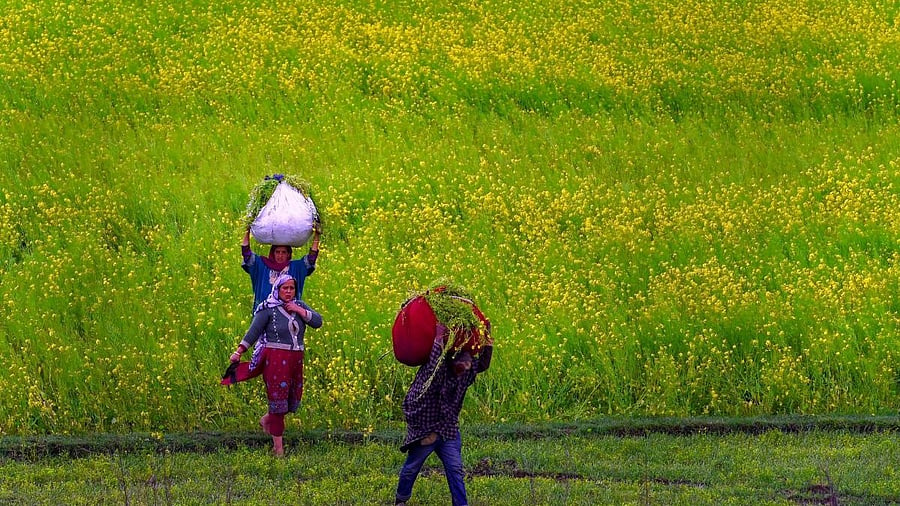
Representative image showing farmers.
Credit: PTI Photo
From the green fields of Uttar Pradesh to the dusty lanes of Unnao, rural India remains the soul of India — where agriculture is not just an occupation, but a way of life. Yet today, that very soul stands strained. Farming — once the pride of our economy — has turned into a struggle for survival.
According to the National Statistical Office (NSO), the average monthly income of an agricultural household in India was a meagre ₹10,218 in 2018-2019. Nearly 57% of farm households were indebted as of 2021. With rising input costs — fertilisers, seeds, and pesticides having increased by more than 20% between 2019 and 2024 — profits have been squeezed to the point of extinction.
Farming has become expensive, uncertain, and heartbreakingly unrewarding. Once, the son of a farmer proudly followed in his father’s footsteps, or aspired for a respectable government job that gave stability and social standing. Today, both dreams have faded. The bond that tied generations to their land has weakened, replaced by uncertainty and migration.
As per the Economic Survey (2023-2024), rural-to-urban migration rose by over 45% between 2011 and 2021. Young villagers, unable to sustain themselves on farms, migrate to cities with little education or skill training. They form the invisible workforce — construction labourers, factory hands, domestic workers — living far from home, often without dignity or security. For every success story we celebrate, there are countless unseen faces struggling to survive.
True national growth cannot be measured by a handful of success stories. It must reflect in the dignity, stability, and income of the many — not in the prosperity of a privileged few.
Over 70% of India’s population still lives in rural areas. Yet, government policies, private investments, and even public imagination remain overwhelmingly urban-centric. Urban infrastructure bursts at the seams as migrants pour in, while rural India waits for its share of opportunity.
Rural infrastructure investment remains below 20% of total capital expenditure (PRS Legislative Research, 2024). This neglect is not merely inefficient — it is unjust. Strengthening our villages is not charity; it is an economic and moral imperative. Studies by NABARD (2022) reveal that every rupee invested in rural roads or irrigation yields 2.5 times the return of comparable urban spending. Investing in the rural economy is not an act of benevolence — it is sound nation-building.
The urban elite often celebrate a ‘booming economy’. But an economy that grows only on paper, inflated by managed markets and inequitable distribution, is hollow at its core. The top 10% of Indian households control 77% of total national wealth, while the bottom 60% share less than 5%.
This is not merely an economic imbalance; it is a social fault line. When one part of India rises while another sinks, the entire structure weakens.
Equally important is the intent of governance. Between 2014 and 2024, India’s agricultural budget allocation grew from ₹27,000 crore to ₹1.16 lakh-crore — yet less than 5% of that reached marginal farmers directly (CAG, 2023). Under flagship schemes like PM-KUSUM and Fasal Bima Yojana, participation remains below 25%, with limited awareness among smallholders.
The gap between policy intent and implementation remains India’s biggest challenge. Farmers do not need slogans; they need systems — in health, education, water, and infrastructure — that sustain their livelihoods. Rural healthcare spending, for instance, remains below 1.2% of GDP (NITI Aayog, 2023), far short of what is needed for a population that forms the majority of our nation.
Over 833 million Indians live across more than six lakh villages, each preserving distinct traditions, languages, and faiths (Census 2011). The UNDP Human Development Report (2023) found that social cohesion and women’s participation are directly linked to rural prosperity and education levels. Rural India is not our past; it is our foundation. If we forget its diversity, we risk losing our compassion.
Our national harmony depends as much on social balance as on economic equity. India cannot — and must not — be forced into a single mould. Ours is a civilisation of many faiths, tongues, and traditions — each deserving respect, each adding to the whole. We are not meant to be uniform; we are meant to be united.
The way forward lies in both compassion and pragmatism. Fair minimum support prices must be enforced. Farmer co-operatives and producer companies must be strengthened. Education must focus on rural skills — from food processing to sustainable farming, from digital access to rural entrepreneurship.
Corporate Social Responsibility (CSR) should not be a tick-box exercise but a moral calling. Similarly, philanthropy — daan and dharm — must be rekindled as acts of national service. Empowering the rural poor is not a favour; it is the foundation of a stronger India.
Farmers and soldiers — the two pillars that hold up India — need not our pity but our partnership. When the farmer stands secure and the soldier stands proud, India stands strong.
Our ancestors believed in balance — dharma that evolved with time but never abandoned its roots. As we modernise, we must remember that progress divorced from the soil is fragile. Revitalising rural India is not nostalgia — it is a necessity. If we wish to build a strong, equitable, and compassionate India, we must begin from the soil — for that is where our nation truly grows.
Annu Tandon, a social worker, is national secretary of the Samajwadi Party, and former Member of Parliament, Unnao. X: @AnnuTandonUnnao.
(Disclaimer: The views expressed above are the author's own. They do not necessarily reflect the views of DH.)